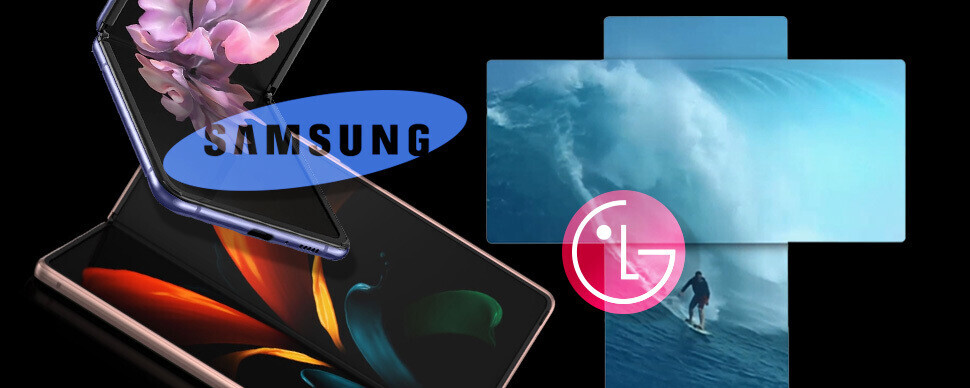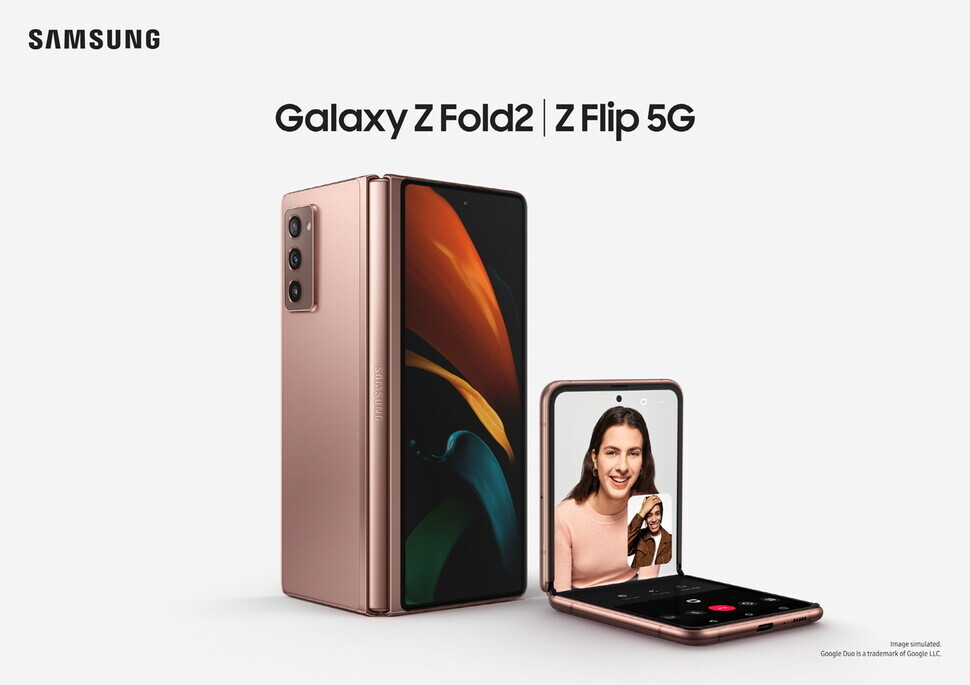hankyoreh
Links to other country sites 다른 나라 사이트 링크
Smartphones form factors becoming increasingly diverse as industry expands and consumers crave variety

Smartphones are getting increasingly diverse in form factor. Following the Galaxy Z Fold 2, which folds sideways like a wallet, and the Galaxy Z Flip and the foldable Motorola Razr, which opens vertically like a clam, we now have a rotating dual-screen phone from LG. What’s behind the emergence of new designs in the smartphone market, which has been dominated, at least until now, by easy-to-hold glass rectangles?

LG set to release “Horizontal Instinct” smartphone
On Sept. 2, LG Electronics announced that its big smartphone release for the second half of the year, tentatively named “Wing,” would be unveiled online at 11 pm on Sept. 14. The basic form factor of the device is presented in material that LG distributed to global media on Wednesday: the top display rotates to reveal another display hidden below. In a teaser video, the screens are presented as a cross, but the dual screens on the actual product will rotate into a T shape — a similar form factor to the popular Anycall SCH-V600 launched by Samsung Electronics in 2004.
LG plans to release the new phone in South Korea in early October. In a presentation to investors about Q2 performance earlier this year, LG said it would be “engineering an improvement in brand image and a conversion in customer attitudes by releasing a phone with a distinct form factor around the US$1,000 price point.”
A smartphone with two screens in a T shape would be well-suited for multitasking. “Some of the advantages of having a main display and a supplementary display are that you could chat while watching a video or load a map or a control pad while playing a mobile game,” said a spokesperson for LG Electronics. “Last year, we sold more than a million units of our previous dual-screen smartphone, so there’s definitely market demand.”

Samsung pioneers new market with four foldable phones
Samsung Electronics unveiled the specifications for the Galaxy Z Fold 2, its third foldable phone, during Galaxy Unpacked 2, an online event on the evening of Sept. 1. The model is priced at 2.4 million won (US$2,021) — the same as its predecessor, the Galaxy Fold, released a year ago — but with much better performance and utility. The plastic display has been replaced with ultra-thin glass, and the screen has gotten bigger: 6.2 inches (from 4.6 inches) when folded and 7.6 inches (from 7.3 inches) when open. When the phone is open, the display covers the entire surface (except for the camera aperture), making better use of the available real estate. Up to three apps can be displayed at the same time, and a drag-and-drop function makes it easy to copy and paste text and images between apps.
Samsung Electronics expanded its range of foldable phones to four with the release of the Galaxy Z Flip 5G model on Wednesday. The Galaxy Fold’s launch was delayed in April 2019 following reports of defects in the folding mechanism, but Samsung’s follow-up models are polishing its image as a pioneering firm in this new market.
According to market research firm Canalys, around 1.74 million foldable phones were shipped from September 2019 to June 30, 2020, with Samsung accounting for 60% of the total, and Huawei and Motorola picking up the rest.

Smartphone design: uniformity and diversity
Smartphone designers have had clear goals since the launch of the iPhone in 2007: maximizing the display by shrinking or eliminating the bezel (or border around the screen); the camera aperture; and the notch around the camera. But this long-standing universal objective of smartphone design has been diversifying more recently, partly because smartphone performance is improving, and partly because users crave more variety. More powerful smartphones are replacing other tools, creating demand for multitasking that goes beyond just viewing media and inputting messages. Foldable phones and dual displays are two attempts to meet that demand.
The success of the new form factors will depend on their weight and durability, and on whether the market can bear the price. Industry analysts are hopeful about the prospects. “Starting next year, diversification of panel suppliers, better yields, and economies of scale will bring prices down to the US$1,000-US$1,500 level,” SK Securities said in a report released on Sept. 2. The report also predicted that the market size would balloon from 3.5 million units this year to 15 million next year and 40 million in 2022.
By Koo Bon-kwon, senior staff writer
Please direct comments or questions to [english@hani.co.kr]

Editorial・opinion
![[Editorial] Penalties for airing allegations against Korea’s first lady endanger free press [Editorial] Penalties for airing allegations against Korea’s first lady endanger free press](https://flexible.img.hani.co.kr/flexible/normal/500/300/imgdb/original/2024/0502/1817146398095106.jpg) [Editorial] Penalties for airing allegations against Korea’s first lady endanger free press
[Editorial] Penalties for airing allegations against Korea’s first lady endanger free press![[Editorial] Yoon must halt procurement of SM-3 interceptor missiles [Editorial] Yoon must halt procurement of SM-3 interceptor missiles](https://flexible.img.hani.co.kr/flexible/normal/500/300/imgdb/child/2024/0501/17145495551605_1717145495195344.jpg) [Editorial] Yoon must halt procurement of SM-3 interceptor missiles
[Editorial] Yoon must halt procurement of SM-3 interceptor missiles- [Guest essay] Maybe Korea’s rapid population decline is an opportunity, not a crisis
- [Column] Can Yoon steer diplomacy with Russia, China back on track?
- [Column] Season 2 of special prosecutor probe may be coming to Korea soon
- [Column] Park Geun-hye déjà vu in Yoon Suk-yeol
- [Editorial] New weight of N. Korea’s nuclear threats makes dialogue all the more urgent
- [Guest essay] The real reason Korea’s new right wants to dub Rhee a founding father
- [Column] ‘Choson’: Is it time we start referring to N. Korea in its own terms?
- [Editorial] Japan’s rewriting of history with Korea has gone too far
Most viewed articles
- 1Bills for Itaewon crush inquiry, special counsel probe into Marine’s death pass National Assembly
- 2[Reporter’s notebook] In Min’s world, she’s the artist — and NewJeans is her art
- 3Months and months of overdue wages are pushing migrant workers in Korea into debt
- 4[Editorial] Penalties for airing allegations against Korea’s first lady endanger free press
- 51 in 3 S. Korean security experts support nuclear armament, CSIS finds
- 6Trump asks why US would defend Korea, hints at hiking Seoul’s defense cost burden
- 7S. Korea discusses participation in defense development with AUKUS alliance
- 860% of young Koreans see no need to have kids after marriage
- 9[Column] Can Yoon steer diplomacy with Russia, China back on track?
- 10At heart of West’s handwringing over Chinese ‘overcapacity,’ a battle to lead key future industries